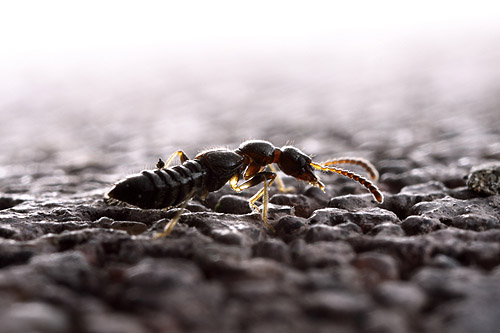 This week was warm enough to go insect hunting in the yard, so the Friday beetle is back with new material. I snapped a few shots of this little staphylinid under a brick, figuring I'd identify it later.
This week was warm enough to go insect hunting in the yard, so the Friday beetle is back with new material. I snapped a few shots of this little staphylinid under a brick, figuring I'd identify it later.
That turned out to be a more complicated process than I'd anticipated.
It's a member of the the subfamily Aleocharinae, the obscure rove beetles. To arrive at an identification any more specific than that is basically impossible. The late James Ashe wrote:
The seemingly endless diversity, the small size of most adults, and the virtual lack of illustrated keys and descriptions of aleocharines for most geographical regions make the Aleocharinae one of the most taxonomically difficult groups of beetles. For example, Casey (1906, 1911), who described most North American aleocharines, did not provide keys to most taxa, and recent comprehensive identification guides (Arnett 1968, Moore and Legner 1974, 1979) did not provide keys to aleocharine genera. Consequently, it is virtually impossible for a specialist in the Staphylinidae to identify the vast majority of aleocharines from most geographic regions even to genus, much less to species...
 What's particularly frustrating about this taxonomic situation is that it can't really be avoided. Aleocharines are common beetles, and there are more than 1,000 species of them on our continent. That is, there are more obscure rove beetle species than there are bird species, but without the array of field guides.
What's particularly frustrating about this taxonomic situation is that it can't really be avoided. Aleocharines are common beetles, and there are more than 1,000 species of them on our continent. That is, there are more obscure rove beetle species than there are bird species, but without the array of field guides. update: Thanks to commentator Adam Brunke, we learn that this mystery rove beetle is Apocellus, in the Oxytelinae rather than the Aleocharinae.
update: Thanks to commentator Adam Brunke, we learn that this mystery rove beetle is Apocellus, in the Oxytelinae rather than the Aleocharinae.
Photo details (all): Canon MP-E 65mm 1-5x macro lens on a Canon EOS 50D
ISO 100, f13, 1/250 sec, flash diffused through tracing paper
- Log in to post comments

Amazing photography, whatever it is. My inability to label it doesn't reduce my sense of wonder.
stunning !!
Are these edible?
Hello Alex, this is actually an oxyteline rove beetle that is often mistaken for an aleocharine. It is an Apocellus, but because the genus isn't revised yet, it could be something other than sphaerocollis which you find often in the east. They tend to like open grassy habitat, a bit drier than most staphs.
Cheers,
Adam
I often find, and am attracted to, staphylinid beetles while ant-hunting. But I gave up trying to identify them just because of what you have written. So I'll just enjoyy them being there, and not even try till the the staphylinologists do something about it.
Andrew, a lot of these have defensive chemicals that make them distasteful, no matter how delicious they might look in Alex's photos.
Thanks Adam. Goodness me, this is even more confusing than I'd thought!
Yay for beetles! I saw my first of the season today, woot!
Nicely done, Alex!
Please don't be discouraged! As a staphylinidologist specializing in aleocharines, especially inquilines, I would like to encourage further myrmecophile collecting. Now that spring is upon us this means myrmecophile season is beginning too. If you see anything with ants I'd love to ID them for you.
Also, post script for Alex: Apocellus is often confused with aleos but the reduced tarsal formula should be a dead give away.